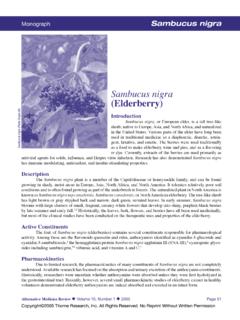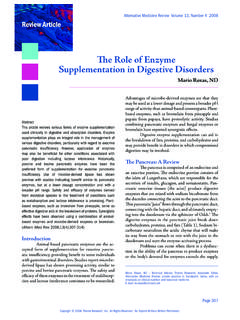Transcription of Pantothenic Acid - altmedrev.com
1 Amr263 Alternative Medicine Review Volume 16, Number 3 Copyright 2011 Alternative Medicine Review, LLC. All Rights Reserved. No Reprint Without Written Permission. MonographDescriptionPantothenic acid (vitamin B5) is a water-soluble B-complex vitamin that was identi!ed in 1933, isolated and extracted from liver in 1938, and !rst synthesized in R. J. Williams is credited with coining the name from the Greek word panthos, which translates as from everywhere. It was given this name because of its widespread presence in vitamin B5, and its derivatives or precur-sors, added to foods and beverages, or used in dietary supplements, is made by chemical ,3 Only the Dextrorotatory (D) isomer of Pantothenic acid D- Pantothenic acid possesses biologic activity. Pure D- Pantothenic acid can be used as a dietary supplement: it is water-soluble, viscous, and yellow in color. Because D- Pantothenic acid is relatively unstable it can be destroyed by heat and acid and alkaline conditions the more stable calcium pantothenate is the form of vitamin B5 usually found in dietary supplements.
2 It is water-soluble, crystalline, and white in color. Ten mg of calcium pantothenate is approximately equivalent to mg of pure D- Pantothenic [Note: A monograph on pantethine was pub-lished in volume 15 of Alternative Medicine Review in ]"e disulphide form of Pantothenic acid pante-thine is also available as a dietary supplement. "is is considered to be the most active form of vitamin B5 because it contains the sulfhydryl-group needed for biological activity in Coenzyme A (CoA).4A liquid form of vitamin B5 dexpanthenol, D-pantothenyl alcohol, D-panthenol, or panthenol is also available. "is is an alcohol pro-vitamin of vitamin B5 ( , it is converted into Pantothenic acid in the body), which is used primarily as a topical or injected form for cosmetic purposes or wound otherwise speci!ed, the supplemental form of vitamin B5 used in studies referenced in this monograph is calcium Sources and IntakeFoods that are considered to be exceptionally good dietary sources of Pantothenic acid include peanut butter (5-8 mg/100 g), liver (5-7 mg/100 g), kidney (4-6 mg/100 g), peanuts (2-3 mg/100 g), almonds (2-3 mg/100 g), wheat bran (2-3 mg/100 g), cheese ( mg/100 g), and lobster ( mg/100 g).
3 "e vast majority of vitamin B5 in foods is found already incorporated into Coenzyme A (CoA) and as Re!ning, freezing, canning and cooking food causes losses of panto-thenic acid, so a modern processed food diet would be expected to have lower amounts of vitamin B5 than a whole foods "e Dietary Reference Intake (DRI) is 5 mg/d of Pantothenic acid for males and females 14 years old and over, 6 mg/d during pregnancy, and 7 mg/d during A 1981 study estimated that the average American diet contains about mg/d of Pantothenic A 2010 population study conducted in Japan, using data from the Nation Health and Nutrition Survey, estimated a daily intake of mg/d of Pantothenic the average intake appears to approximate the DRI, subsets of the population might be at higher risk for insu#cient intake. A dietary analysis of healthy adolescents reported that 49 percent of the females and 15 percent of the males consumed less than 4 mg/day of Pantothenic acid in their A study of Hispanic children, considered to be of low socioeconomic status, conducted in Houston, Texas, indicated that Pantothenic acid intake was extremely variable and below recommended intake for many of the studied "e diet of residents of a Gregory S.
4 Kelly, ND Senior editor for Alternative Medicine Review; consultant for Lifestrive; co-owner of Health Coach; author of the book Shape Shift. Email: Acid Gregory S. Kelly, NDamrVolume 16, Number 3 Alternative Medicine Review 264 Copyright 2011 Alternative Medicine Review, LLC. All Rights Reserved. No Reprint Without Written Permission. MonographKeywords: Pantothenic acid, vitamin B5, B5, acne, adrenal, aldehydes, alopecia, anti-aging, celiac, chemicals, ergogenic, hyperlipidemia, lifespan, lupus, obesity, osteoarthritis, rheumatoid arthritis, SLE, stress, ulcerative colitis, woundsnorthern Utah nursing home had a mean daily Pantothenic acid content of A study conducted at a long-term care facility for the aged a#liated with the University of Toronto s Medical School reported that neither of the two most commonly fed diet types unrestricted diet and lactose-free diet supplied su#cient quantities of Pantothenic A study conducted in 100 free-living elderly individuals in Greece reported that their Mediterranean-style diet was insu#cient in Pantothenic circumstances might also be risk factors for insu#ciency.
5 A study reported that Pantothenic acid levels were signi!cantly lower in females using oral contraceptives compared with females who were "e daily mean dietary intake of pregnant women was estimated as mg/1,000 "is would supply an inadequate amount of Pantothenic acid for pregnant women consuming the low-to-moderate range of recommended calories during pregnancy. "e mean Pantothenic acid intake of lactating women was estimated as mg/d over a 6-month period,17 which exceeds their elicit severe signs of Pantothenic acid de!ciency in mice, treatment with an antibiotic is necessary. Presumably this occurs because su#-cient Pantothenic acid to ward o$ signs of severe de!ciency is produced by intestinal It s possible that intestinal %ora contributes to overall vitamin B5 status in humans; however, this area has not been acid is used in CoA and acyl carrier proteins (ACP), which carry and transfer acetyl and acyl groups, respectively.
6 In vivo e$ects of panto-thenic acid are generally thought to be a result of its incorporation into these is an essential cofactor in fatty acid oxida-tion, lipid elongation, and fatty acid synthesis. It is involved in the production of many secondary metabolites such as polyisoprenoid-containing compounds ( , dolichol, ubiquinone [CoQ10], squalene, and cholesterol), steroid molecules ( , steroid hormones, vitamin D and bile acids), acetylated compounds ( , acetylated derivatives of amino sugars [ , N-acetylglucosamine], acetylated neurotransmitters [ , N-acetylserotonin, acetylcholine]), and prostaglan-dins and prostaglandin-like compounds. Biosynthesis of phospholipids ( , phosphatidyl-choline, -ethanolamine, -serine, -inositol, -cardiolipin), as well as plasmalogen, sphingenin, and ceramide, require CoA. Directly or indirectly, CoA is involved in the breakdown of the carbon skeleton of most of the amino acids.
7 "e break-down of the pyrimidine bases, cytosine, uracil, and thymine, is also dependent on ACP is involved in fatty acid synthases, polyketide synthases, lysine synthesis, and nonribosomal peptide plants and microorganisms accomplish biosynthesis of Pantothenic acid by enzymatically combining pantoic acid with -alanine. Mammals lack the enzyme for this synthetic step, so are unable to synthesize Pantothenic mammals, endogenous synthesis of CoA and ACP can begin with Pantothenic acid. "e biosyn-thetic pathway begins with a phosphorylation reaction catalyzed by a magnesium-dependent enzyme pantothenate kinase (also called panto-thenic acid kinase) resulting in the formation of 4 -phosphopantothenic acid (4 -PPA).2,3,19 "is step is considered the most important control step in the biosynthesis of Pantothenic acid-dependent "e next step is a condensation reaction with cysteine, producing 4 -phosphopantothenoyl cysteine.
8 In the absence of cysteine, 4 -PPA will accumulate, suggesting that the absence of cysteine as a substrate is a limiting factor in the biosynthesis of Pantothenic acid s down-line metabolites. 4 -Phosphopantetheine (4 -PP) is then formed by a decarboxylation ,3 "e reaction rate of this enzymatic step is also increased by the availability of protein-sulfhydryl compounds such as "e !nal two steps in the synthesis of CoA involve the addition of an adenosyl group derived from ATP and the phos-phorylation of this molecule. Both of these enzymatic reactions require magnesium as a ,3 CCCCH2 OHHCH3 OHCH3 HOOCCH2CH2 NHOamr265 Alternative Medicine Review Volume 16, Number 3 Copyright 2011 Alternative Medicine Review, LLC. All Rights Reserved. No Reprint Without Written Permission. MonographWhile CoA accounts for a large proportion of cellular Pantothenic acid, ACP also contains the Pantothenic acid molecule.
9 "e synthesis of ACP is not completely elaborated; however, as in CoA, 4 -PP has been identi!ed as the prosthetic and PharmacokineticsExisting evidence suggests that the bioavailabil-ity of Pantothenic acid is in the range of 40-63 ,22 Pantothenic acid appears to be absorbed rapidly following an oral dose, resulting in increased tissue levels of CoA and other panto-thenic acid metabolites within six Content of CoA and Pantothenic acid increases signi!cantly in leukocytes and urine 6-24 hours after oral mice, Pantothenic acid absorption occurs in the small intestine, and is sodium-dependent and saturable. Varying the dietary intake of Pantothenic acid low, normal, or high doses has no physi-ologically signi!cant e$ect on small intestinal Pantothenic acid is absorbed and trans-ported into cells, it can be converted to CoA or ACP by the series of enzymatic reactions previously described.
10 In animals, Pantothenic acid appears to concentrate in the liver,24,25 muscles, and Animal experiments suggest that Pantothenic acid can enter and leave the brain and cerebral spinal %uid by saturable transport acid is found in the breast milk of lactating women. Amounts found correlate to the amount of Pantothenic acid in the diet of the mother the day preceding milk "e amount of Pantothenic acid found in a 24-hour urine sample appears to accurately re%ect intake during the past several days in ,22,29 Blood Pantothenic acid levels respond less readily to intake than levels found in urine and are not considered as reliable an Levels of Pantothenic acid in erythrocytes correlate with dietary intake and urinary !ciencyOutright de!ciency of Pantothenic acid does not appear to occur under usual circumstances. Presumably this is a result of (1) Pantothenic acid being found in a wide variety of foods in adequate amounts to prevent de!






